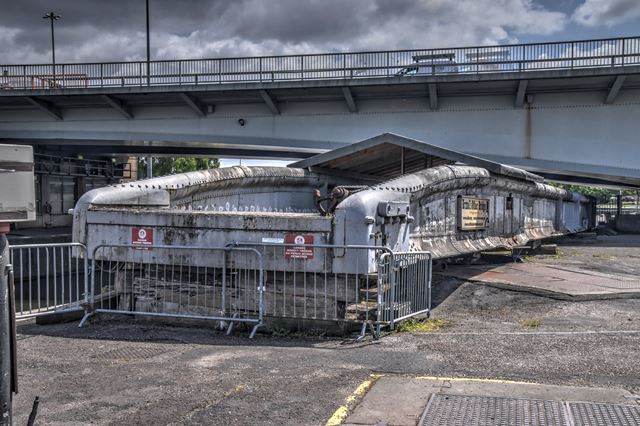We Recommend:
Bach Steel - Experts at historic truss bridge restoration.
Brunel Swivel Bridge
Brunel Swing Bridge

Primary Photographer(s): Nathan Holth
Bridge Documented: May 11, 2018
Lock Access Road Over Cumberland Basin (North Entrance Lock and South Entrance Lock)
Bristol: South West, England: United Kingdom
Metal Through Girder, Movable: Swing (Rim Bearing Bobtail) and Approach Spans: Metal Through Girder, Fixed
1849 By Builder/Contractor: Unknown and Engineer/Design: Isambard Kingdom Brunel
Not Available or Not Applicable
110.5 Feet (33.7 Meters)
Not Available
12 Feet (3.66 Meters)
1 Main Span(s) and 1 Approach Span(s)
Not Applicable

View Information About HSR Ratings
Bridge Documentation
Visit The Official Website For This Bridge, And Learn How To Help Restore This Bridge
View Paper About This Bridge By David Greenfield
This bridge is sometimes called "Brunel's Other Bridge" because it is less famous than the Clifton Suspension Bridge, also associated with famous engineer Isambard Kingdom Brunel.
This is an extremely old example of a metal swing bridge, and also noted as a surviving example of a girder bridge designed by Isambard Kingdom Brunel. The bridge has a complicated history. There are technically two different bridges at this location, separated by a short amount of land, although HistoricBridges.org is listing them here on the same page. The span over the North Entrance Lock originally spanned the South Entrance Lock when built in 1844. It was moved in 1873 to its current location. After that was completed, a replica girder bridge of matching Brunel design was built over the South Entrance Lock in 1875-6. Today, the South Entrance Lock span does not operate as a swing span, and it is called the Fixed Span on HistoricBridges.org. The North Entrance Lock, although it has not operated for many years, does retain its swing ability and associated machinery.
The swing bridge, which is not currently in use, has deteriorated. Fortunately, a group is making an extensive effort to study, evaluate, and restore this bridge. The process is more than just repairing deterioration; the bridge is being studied to learn how it was designed, how it works, and the effort is to fully design and execute a project that will return the bridge to its original operating conditions. An extraordinary effort has been made to produce extensive drawings, 3D models, and detailed measurements of the bridge. The design work as well as the physical inspection and repair work is an ongoing effort that is supported by donations and volunteers. Visit the group's website to learn more about this impressive effort. Please also consider a donation to this admirable effort to preserve this important historic bridge.
This is one of the most historically significant movable bridges in the United Kingdom. Unlike the Clifton Suspension Bridge, Brunel was actually alive when this bridge was built, so in many ways this bridge is more part of Brunel's history than the more famous Clifton Suspension Bridge. This bridge is also important in interpreting another historic bridge, the Royal Albert Bridge. Brunel's design for the fixed girder span matches the design he used for the approach spans on the Royal Albert Bridge. These approach spans were replaced on the Royal Albert Bridge, so this bridge offers a look at what the originals looked like. The tubular top chord, and the skewed floorbeams are both signature design details that Brunel used in both bridges.
Grace's Guide has additional details about this swing bridge.
Official Heritage Listing Information and FindingsListed At: Grade II* Discussion: List Entry Number (Swing Span, North Entrance Lock):
|
![]()
Photo Galleries and Videos: Brunel Swivel Bridge
Bridge Photo-Documentation
Original / Full Size PhotosA collection of overview and detail photos. This gallery offers photos in the highest available resolution and file size in a touch-friendly popup viewer.
Alternatively, Browse Without Using Viewer
![]()
Bridge Photo-Documentation
Mobile Optimized PhotosA collection of overview and detail photos. This gallery features data-friendly, fast-loading photos in a touch-friendly popup viewer.
Alternatively, Browse Without Using Viewer
![]()
Maps and Links: Brunel Swivel Bridge
Coordinates (Latitude, Longitude):
Search For Additional Bridge Listings:
Additional Maps:
Google Streetview (If Available)
GeoHack (Additional Links and Coordinates)
Apple Maps (Via DuckDuckGo Search)
Apple Maps (Apple devices only)
Android: Open Location In Your Map or GPS App
Flickr Gallery (Find Nearby Photos)
Wikimedia Commons (Find Nearby Photos)
Directions Via Sygic For Android
Directions Via Sygic For iOS and Android Dolphin Browser
Ordnance Survey Maps (UK Only)

